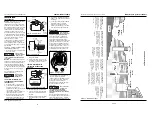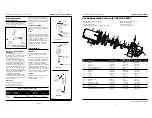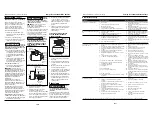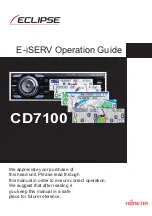
(A) MANANTIAL:
Un manantial que emerge
de la tierra. Ocurre cuando
el agua en materiales
permeables está atrapada
entre materiales
impermeables tales como
roca o arcilla.
(B) LAGO, ARROYO o EST
ANQUE:
Agua superficial, que a menos
que sea tratada, por lo general
no es apta para consumo
humano. Puede ser utilizada
para fines tales como lavado
o irrigación.
(C) POZO EXCA
V
ADO:
Se excava un hoyo de
varios pies de diámetro
hasta una profundidad
basante superficial.
Luego se reviste con
ladrillo, piedra o
concreto para evitar
que se derrumbe.
(D) POZO ACCIONADO:
Se acciona una tubería
con una pantalla con
punta en la tierra, por
debajo de la capa
freática. La profundidad
por lo general es menor
a 15,25 m (50 pies).
Los diámetros comunes
fluctúan entre 2,5 cm (1")
y 5,1 cm (2")
(E) POZO PERFORADO:
Un hoyo perforado en
la tierra con maquinaria y
revestido con tuberías.
Las profundidades
fluctúan entre algunos
pies hasta más de 305 m
(1000 pies). Los diámetros
comunes son 5,1 cm (2"),
7,6 cm (3"), 10,2 cm (4") y
15,2 cm (6") para pozos
de agua de uso doméstico.
(F) CISTERNA:
Un tanque subterráneo
construido para recolectar
agua de lluvias de los
techos. El agua no es
apta para consumo
humano.
(A) MANANTIAL
(B) LAGO,
ARROYO,
EST
ANQUE
(C) POZO EXCA
V
ADO
(D) POZO
ACCIONADO
(E) POZO
PERFORADO
(F) CISTERNA
MA
TERIAL
PERMEABLE
ARENA
ACUIFERA
CAP
A FREA
TICA
ESQUISTO
TIERRA
SUPERFICIAL
ARCILLA
Suministr
os de Agua
Figura 13 - Suministros de Agua
29 Sp
Manual de instrucciones de operación y piezas
Modelos para pozos profundos
noise transmitted to the house
thrugh the piping.
4. Provide a hose bib (faucet) at the
lowest point in the system to drain
the system for service or storage.
SHALLOW WELL PUMP WITH
PRECHARGED STORAGE TANK
(FIGURE 6)
1. Shut off the power to the pump.
2. Open the faucet nearest the tank
and allow all water to drain from
the tank.
3. Measure the tank precharge at the
valve stem using a tire pressure
gauge.
4
4. If necessary, precharge with an air
pump to 28 - 30 psi on 1/2, 3/4 and 1
HP pumps.
5. Slope the horizontal pipes upward
toward the pump to prevent
trapping air. If the horizontal
distance exceeds 25 feet, see Chart
2 for the recommended pipe size.
Electrical
Risk of electrical
shock. This pump is
designed for indoor installation only.
The voltage of power supply must
match the voltage of the pump. All
above ground well pumps except
SWS50BOOST have dual voltage motors
preset at the factory to 230 volts. The
motors can be converted to 115 volts
by turning the voltage selector to the
desired voltage (See Figure 7). Use a
needle nose pliers to pull the selector
out approximately 1/4”, rotate and
then reinsert in correct position.
Select the proper size wire and fuse
(Chart 3). Time delay fuses are
recommended over standard fuses for
motor circuit protection. All pump
motors have built-in automatic
overload protection that will prevent
damage to the motor due to
overheating.
Do not connect to
electric power
supply until unit is permanently
grounded. Connect ground wire to
approved ground then connect terminal
provided.
A metal underground water pipe or
well casing at least 10 feet long makes
the best ground electrode. If plastic
pipe or insulated fittings are used, run
!
WARNING
!
WARNING
Installation
(Continued)
NOTE:
A packer type foot valve can be
installed in the well (Figure 3,
Illustration B). This type of foot valve
allows the well to be filled with water
when priming and makes the inlet pipe
much easier to test for leaks. Follow
the manufacturer’s instructions when
installing the packer type foot valve.
As an alternative, an in-line check valve
can be used with a driven well (Figure
3, Illustration C). The pipe between the
check valve and the water level will
always be under a vacuum.
Leaking joints or couplings will allow
air to leak into the pipe and cause
abnormal pump operation. Make sure
to use pipe joint compound on all male
pipe threads.
DUG WELL, CISTERN, LAKE AND SPRING
INSTALLATION (FIGURE 12)
1. Install a foot valve on inlet pipe and
lower into water.
The foot valve
should be at least
18” from the bottom of the well or
sand or sediment could be drawn into
the system.
NOTE:
When a lake is used as a water
supply, make sure the inlet pipe is deep
enough to be submerged at all times.
Slope the horizontal piping upward
toward the pump to prevent trapping
air. The pipe must be removed during
winter months or protected against
freezing.
Protect the pipe from damage from
swimmers and boats.
Install a screen
around the inlet
pipe to prevent the entrapment of
swimmers.
SHALLOW WELL PUMP WITH
CONVENTIONAL STORAGE TANK
(FIGURES 4 & 5)
1. Install air volume control on tank.
2. Connect the copper tube from the
air volume control to the
uppermost 1/8” NPT opening on the
side of pump. Be sure the
connections are tight. Leaking can
cause the pump not to prime.
3. Install a valve and an isolator hose
between the tank and the house
plumbing to aid in pump removal
for servicing and for reducing the
!
WARNING
!
CAUTION
Operating Instructions and Parts Manual
Shallow Well Jet Pump
Figure 4 - Horizontal Tank
Air
Volume
Control
Tubing
Pressure
Switch
Prime
Plug
Air
Volume
Control
Figure 5 - Vertical Tank
Air
Volume
Control
Outlet
Air Volume
Control
Tubing
Hose
Coupling
Figure 6 - Precharged Storage Tank
28-30 psi
3/4 HP & 1 HP
Motor
www.waynewatersystems.com
Outlet
Priming
Plug
Nozzle
Clean
Out
Drain
Fitting
115 V
230 V
115 V
230 V
Figure 7 - Voltage Selector


































